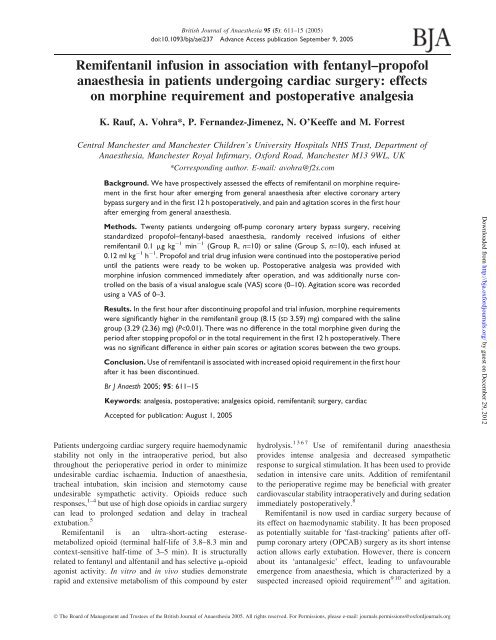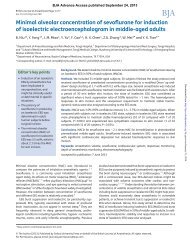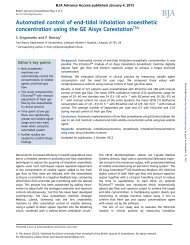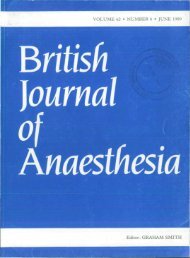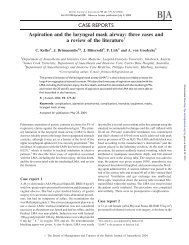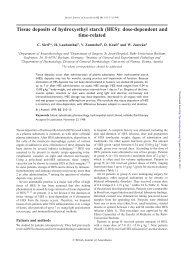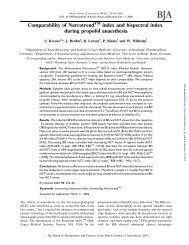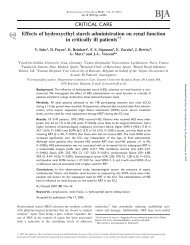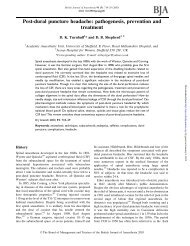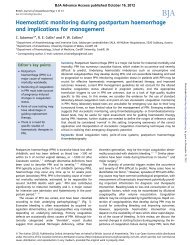Remifentanil infusion in association with fentanyl–propofol ... - BJA
Remifentanil infusion in association with fentanyl–propofol ... - BJA
Remifentanil infusion in association with fentanyl–propofol ... - BJA
Create successful ePaper yourself
Turn your PDF publications into a flip-book with our unique Google optimized e-Paper software.
British Journal of Anaesthesia 95 (5): 611–15 (2005)<br />
doi:10.1093/bja/aei237 Advance Access publication September 9, 2005<br />
<strong>Remifentanil</strong> <strong><strong>in</strong>fusion</strong> <strong>in</strong> <strong>association</strong> <strong>with</strong> <strong>fentanyl–propofol</strong><br />
anaesthesia <strong>in</strong> patients undergo<strong>in</strong>g cardiac surgery: effects<br />
on morph<strong>in</strong>e requirement and postoperative analgesia<br />
K. Rauf, A. Vohra*, P. Fernandez-Jimenez, N. O’Keeffe and M. Forrest<br />
Central Manchester and Manchester Children’s University Hospitals NHS Trust, Department of<br />
Anaesthesia, Manchester Royal Infirmary, Oxford Road, Manchester M13 9WL, UK<br />
*Correspond<strong>in</strong>g author. E-mail: avohra@f2s.com<br />
Background. We have prospectively assessed the effects of remifentanil on morph<strong>in</strong>e requirement<br />
<strong>in</strong> the first hour after emerg<strong>in</strong>g from general anaesthesia after elective coronary artery<br />
bypass surgery and <strong>in</strong> the first 12 h postoperatively, and pa<strong>in</strong> and agitation scores <strong>in</strong> the first hour<br />
after emerg<strong>in</strong>g from general anaesthesia.<br />
Methods. Twenty patients undergo<strong>in</strong>g off-pump coronary artery bypass surgery, receiv<strong>in</strong>g<br />
standardized propofol–fentanyl-based anaesthesia, randomly received <strong><strong>in</strong>fusion</strong>s of either<br />
remifentanil 0.1 mg kg 1 m<strong>in</strong> 1 (Group R, n=10) or sal<strong>in</strong>e (Group S, n=10), each <strong>in</strong>fused at<br />
0.12 ml kg 1 h 1 . Propofol and trial drug <strong><strong>in</strong>fusion</strong> were cont<strong>in</strong>ued <strong>in</strong>to the postoperative period<br />
until the patients were ready to be woken up. Postoperative analgesia was provided <strong>with</strong><br />
morph<strong>in</strong>e <strong><strong>in</strong>fusion</strong> commenced immediately after operation, and was additionally nurse controlled<br />
on the basis of a visual analogue scale (VAS) score (0–10). Agitation score was recorded<br />
us<strong>in</strong>g a VAS of 0–3.<br />
Results. In the first hour after discont<strong>in</strong>u<strong>in</strong>g propofol and trial <strong><strong>in</strong>fusion</strong>, morph<strong>in</strong>e requirements<br />
were significantly higher <strong>in</strong> the remifentanil group (8.15 (SD 3.59) mg) compared <strong>with</strong> the sal<strong>in</strong>e<br />
group (3.29 (2.36) mg) (P
The evidence for this effect is equivocal. Studies of volunteers<br />
and non-cardiac surgery patients have concluded that<br />
there is no tolerance to remifentanil. 11–13 However, it is<br />
notable that previous studies have focused on the period<br />
12–24 h postoperatively and not on the first hour.<br />
The purpose of this prospective randomized double-bl<strong>in</strong>d<br />
controlled study was to determ<strong>in</strong>e the effects of remifentanil<br />
on postoperative analgesia requirement <strong>in</strong> patients undergo<strong>in</strong>g<br />
OPCAB surgery. The ma<strong>in</strong> aim of the study was<br />
to assess the analgesic requirement <strong>in</strong> the first hour after<br />
stopp<strong>in</strong>g remifentanil <strong><strong>in</strong>fusion</strong> as well as for the 12 h after<br />
the end of surgery.<br />
Methods<br />
After local ethics committee approval and <strong>in</strong>formed written<br />
consent, 20 adult patients undergo<strong>in</strong>g elective OPCAB<br />
were recruited for this prospective double-bl<strong>in</strong>d study.<br />
The sample size was chosen on the basis of power calculation<br />
from a pilot study of morph<strong>in</strong>e requirement. It was<br />
calculated that a sample size of 10 <strong>in</strong> each group would<br />
have 88% power us<strong>in</strong>g a two-tailed Student’s t-test <strong>with</strong><br />
a significance level of 0.05 for detect<strong>in</strong>g a difference <strong>in</strong><br />
morph<strong>in</strong>e consumption of at least 100% dur<strong>in</strong>g the first hour.<br />
Inclusion criteria were elective OPCAB and age 18–75<br />
years. Patients were excluded preoperatively if they gave<br />
a history of severely impaired cardiac function, severe<br />
pulmonary disease, diabetes mellitus, renal failure, drug<br />
dependence or uncontrolled hypertension. Those requir<strong>in</strong>g<br />
emergency surgery were also excluded. Postoperative<br />
exclusions <strong>in</strong>cluded reoperation, excessive bleed<strong>in</strong>g and<br />
prolonged ventilation (>12 h).<br />
The patients cont<strong>in</strong>ued their usual medications <strong>in</strong>clud<strong>in</strong>g<br />
all cardiac drugs. All patients received standardized premedication<br />
<strong>with</strong> temazepam 20–30 mg, metoclopramide<br />
10 mg and sucralfate 2 g, given 90 m<strong>in</strong> before operation.<br />
All patients were monitored accord<strong>in</strong>g to standard guidel<strong>in</strong>es.<br />
In addition, direct arterial and central venous pressure<br />
monitor<strong>in</strong>g was established. Anaesthesia was <strong>in</strong>duced us<strong>in</strong>g<br />
target-controlled <strong><strong>in</strong>fusion</strong> (TCI) of propofol <strong>with</strong> the target<br />
at 2.5–4 mg ml 1 (Astra–Zeneca, Macclesfield, UK),<br />
fentanyl 15 mg kg 1 and rocuronium 1.5 mg kg 1 . The<br />
trachea was <strong>in</strong>tubated 3 m<strong>in</strong> after <strong>in</strong>duction. The patients<br />
were ventilated <strong>with</strong> oxygen-enriched air (50% oxygen).<br />
Anaesthesia was ma<strong>in</strong>ta<strong>in</strong>ed <strong>with</strong> TCI propofol <strong>with</strong> the<br />
target between 1.8 and 4 mgml 1 , guided by haemodynamic<br />
parameters. Muscle relaxation was ma<strong>in</strong>ta<strong>in</strong>ed <strong>with</strong> boluses<br />
of rocuronium 10–20 mg as required.<br />
On the morn<strong>in</strong>g of surgery patients were randomly allocated<br />
to one of the two groups us<strong>in</strong>g a closed-envelope<br />
system. An anaesthetist, not directly <strong>in</strong>volved <strong>in</strong> the study,<br />
prepared the <strong><strong>in</strong>fusion</strong> which consisted of four 50 ml<br />
syr<strong>in</strong>ges. The <strong><strong>in</strong>fusion</strong> was started 5 m<strong>in</strong> after <strong>in</strong>duction<br />
of anaesthesia as follows: Group R (remifentanil, n=10),<br />
remifentanil 50 mg ml 1<br />
at an <strong><strong>in</strong>fusion</strong> rate of<br />
0.12 ml kg 1 h 1 (equivalent to 0.1 mg kg 1 m<strong>in</strong> 1 );<br />
Rauf et al.<br />
Group S (control, n=10), normal sal<strong>in</strong>e 0.9% given at an<br />
<strong><strong>in</strong>fusion</strong> rate of 0.12 ml kg 1 h 1 .<br />
The anaesthetist(s) <strong>in</strong> charge, the nurses on the postoperative<br />
unit and the <strong>in</strong>vestigator were bl<strong>in</strong>ded to the nature<br />
of <strong><strong>in</strong>fusion</strong>. Blood pressure and heart rate were ma<strong>in</strong>ta<strong>in</strong>ed<br />
<strong>with</strong><strong>in</strong> 20% of the preoperative measurements us<strong>in</strong>g cardiovascular<br />
drugs at the anaesthetist’s discretion. Interventions<br />
used for rais<strong>in</strong>g or lower<strong>in</strong>g the blood pressure or heart<br />
rate were recorded. Heart rate (HR), systolic arterial<br />
blood pressure (SAP) and mean arterial pressure (MAP)<br />
were recorded from 5 m<strong>in</strong> before <strong>in</strong>duction of anaesthesia<br />
to 1 h after commencement of surgery, and 5 m<strong>in</strong> before and<br />
every 5 m<strong>in</strong> for 90 m<strong>in</strong> after the end of surgery.<br />
At the end of surgery, patients were kept sedated <strong>with</strong><br />
propofol 100–200 mg h 1 , <strong><strong>in</strong>fusion</strong> of the study drug was<br />
cont<strong>in</strong>ued and morph<strong>in</strong>e 1–2 mg h 1 was started. Patients<br />
were transferred to the cardiac <strong>in</strong>tensive care unit (CICU).<br />
Tracheal extubation was performed when the patients were<br />
cardiovascularly stable, were normothermic (central temperature<br />
>36.5 C), were not bleed<strong>in</strong>g (7 mlkg 1 , Fio2
Table 1 Patient characteristics and operative data. Group R, remifentanil; Group<br />
S, sal<strong>in</strong>e. Data are presented as mean (SD) or median (range). There were no<br />
significant differences between groups<br />
Results<br />
Group R (n=10) Group S (n=10)<br />
Age (yr) 62 (34–75) 60 (48–69)<br />
Male/female 8/2 8/2<br />
Weight (kg) 85.9 (18.3) 78.5 (14.3)<br />
Height (cm) 171.5 (8) 170.5 (6.6)<br />
Duration of surgery (m<strong>in</strong>) 196 (52.7) 198 (35)<br />
Total duration of study <strong><strong>in</strong>fusion</strong> (m<strong>in</strong>) 499.4 (81) 482.7 (88)<br />
Propofol dose (<strong>in</strong>traoperative) (mg) 1766 (517) 1967 (447)<br />
Postoperative sedation time (m<strong>in</strong>) 264 (97.4) 226 (90.7)<br />
Extubation time (m<strong>in</strong>) 575 (257) 390 (218)<br />
Table 2 Results show<strong>in</strong>g changes <strong>in</strong> heart rate (HR), systolic arterial pressure<br />
(SAP) and mean arterial pressure (MAP) before (pre-) and after (post-) stopp<strong>in</strong>g<br />
propofol. Data are presented as mean (SD). *P=0.06; **P=0.016<br />
Group R (n=10) Group S (n=10)<br />
No. of patients requir<strong>in</strong>g drugs<br />
to stabilize haemodynamics*<br />
2 6<br />
HR pre-sedation (beats m<strong>in</strong> 1 ) 76 (15) 72 (7)<br />
HR post-sedation (beats m<strong>in</strong> 1 ) 84 (15) 77 (8)<br />
SAP pre-sedation (mm Hg) 125 (18) 129 (10)<br />
SAP post-sedation (mm Hg) 143 (12) 135 (6)<br />
MAP pre-sedation (mm Hg) 85 (12) 87 (9)<br />
MAP post-sedation (mm Hg)** 97 (6) 89.5 (5)<br />
All 20 patients completed the study. Both groups had similar<br />
characteristics and operation data (Table 1).<br />
There were no significant differences between haemodynamic<br />
variables <strong>in</strong> the two groups dur<strong>in</strong>g the <strong>in</strong>traoperative<br />
period (Table 2). Two patients <strong>in</strong> Group R compared<br />
<strong>with</strong> six <strong>in</strong> Group S required pharmacological measures<br />
to stabilize arterial blood pressure and HR <strong>in</strong>traoperatively,<br />
but this was not statistically significant (P=0.06). The two<br />
patients <strong>in</strong> Group R required metaram<strong>in</strong>ol to ma<strong>in</strong>ta<strong>in</strong> their<br />
MAP <strong>with</strong><strong>in</strong> 20% of pre-<strong>in</strong>duction value, whereas the six<br />
patients <strong>in</strong> Group S required isoflurane, glyceryl tr<strong>in</strong>itrate<br />
(GTN) or b-blocker drugs to lower MAP <strong>with</strong><strong>in</strong> that range.<br />
Intraoperative propofol dose was 1967 (447) mg <strong>in</strong> Group S<br />
and 1766 (517) mg <strong>in</strong> Group R (P=0.18) (Table 1).<br />
There were no significant differences <strong>in</strong> HR, MAP and<br />
SAP between the two groups before stopp<strong>in</strong>g sedation. In<br />
Group R, HR, MAP and SAP <strong>in</strong>creased significantly after<br />
stopp<strong>in</strong>g sedation (P
follow<strong>in</strong>g <strong><strong>in</strong>fusion</strong> of propofol for target-controlled<br />
anaesthesia and postoperative sedation for >8 h <strong>in</strong> total<br />
significantly <strong>in</strong>creased the requirement for morph<strong>in</strong>e <strong>in</strong><br />
the first hour follow<strong>in</strong>g cessation of propofol compared<br />
<strong>with</strong> a placebo group. This significant difference had disappeared<br />
12 h after surgery. Previous studies of pa<strong>in</strong> and<br />
analgesia requirements have shown differ<strong>in</strong>g results. This<br />
appears, <strong>in</strong> part at least, to be due to the heterogeneity<br />
of study design. For <strong>in</strong>stance, Guignard and colleagues 9<br />
studied patients undergo<strong>in</strong>g major abdom<strong>in</strong>al surgery, of<br />
duration >2 h, <strong>with</strong> desflurane–remifentanil anaesthesia.<br />
They compared a group receiv<strong>in</strong>g desflurane 0.5 m<strong>in</strong>imal<br />
alveolar concentration (MAC) and variable <strong><strong>in</strong>fusion</strong> of<br />
remifentanil ( 0.3 mg kg 1 m<strong>in</strong> 1 ) <strong>with</strong> a group receiv<strong>in</strong>g<br />
a fixed <strong><strong>in</strong>fusion</strong> of remifentanil 0.1 mg kg 1 m<strong>in</strong> 1 <strong>with</strong><br />
variable desflurane concentration ( 0.7 MAC). They<br />
found that the patients receiv<strong>in</strong>g the higher concentration<br />
of remifentanil had higher pa<strong>in</strong> scores <strong>in</strong> the first 45 m<strong>in</strong>,<br />
3 h and 4 h after extubation. In addition, they found that<br />
these patients required morph<strong>in</strong>e at an earlier time and had<br />
greater cumulative morph<strong>in</strong>e consumption over 24 h.<br />
Cort<strong>in</strong>ez and colleagues 11 studied pa<strong>in</strong> and morph<strong>in</strong>e<br />
requirements <strong>in</strong> patients undergo<strong>in</strong>g gynaecological surgery.<br />
They found no difference <strong>in</strong> analgesic requirement dur<strong>in</strong>g<br />
the first hour or the first 12 h postoperatively. However, it<br />
is important to note that their patients received remifentanil<br />
for 8 h was associated <strong>with</strong> an <strong>in</strong>crease <strong>in</strong> morph<strong>in</strong>e<br />
requirement dur<strong>in</strong>g the first hour but not at 12 h. This<br />
occurred despite use of fentanyl 15 mg kg 1 at <strong>in</strong>duction<br />
of anaesthesia and morph<strong>in</strong>e <strong><strong>in</strong>fusion</strong> for 4 h prior to<br />
term<strong>in</strong>ation of remifentanil. The first hour, compar<strong>in</strong>g<br />
remifentanil <strong>with</strong> placebo, has not previously been evaluated<br />
<strong>in</strong> patients receiv<strong>in</strong>g <strong><strong>in</strong>fusion</strong> for >2 h. This could expla<strong>in</strong><br />
why some previous studies have failed to show any difference<br />
<strong>in</strong> pa<strong>in</strong> or morph<strong>in</strong>e requirements. It appears that dose<br />
and duration of remifentanil are important factors <strong>in</strong> this<br />
hyperalgesia phenomenon. It may also be that the nature<br />
of surgery may affect the f<strong>in</strong>d<strong>in</strong>gs of different studies.<br />
Whether it is the duration of remifentanil <strong><strong>in</strong>fusion</strong> or the<br />
total dose that is more important <strong>in</strong> the development of<br />
hyperalgesia rema<strong>in</strong>s unclear. Future studies aimed at elucidat<strong>in</strong>g<br />
this would be useful.<br />
Fletcher and colleagues 14 have suggested that either acute<br />
tolerance occurs dur<strong>in</strong>g <strong><strong>in</strong>fusion</strong> or the rapid offset of the<br />
drug from the opioid receptor <strong>with</strong> the slower attachment of<br />
opioids <strong>with</strong> less aff<strong>in</strong>ity is the cause of the pa<strong>in</strong> and agitation<br />
seen follow<strong>in</strong>g cessation of remifentanil. In our study,<br />
a significant difference <strong>in</strong> morph<strong>in</strong>e requirement was seen <strong>in</strong><br />
the first hour but not at 12 h. Unfortunately, we did not look<br />
at times between and do not know when the effect ceased to<br />
be significant. However, it is clear from our results that most<br />
of the difference <strong>in</strong> the absolute dosages of morph<strong>in</strong>e<br />
occurred between 15 and 30 m<strong>in</strong>. This fits well <strong>with</strong> the<br />
relative pharmacok<strong>in</strong>etics of remifentanil and morph<strong>in</strong>e<br />
Rauf et al.<br />
614<br />
(remifentanil has a context-sensitive half-life of 8 m<strong>in</strong>,<br />
and onset time for i.v. morph<strong>in</strong>e is about 20 m<strong>in</strong>) and<br />
would provide evidence for this theory. The observation<br />
that morph<strong>in</strong>e prior to cessation of remifentanil has made<br />
no difference may be due to the relative aff<strong>in</strong>ities of the two<br />
drugs for the m-opioid receptor or perhaps the small doses of<br />
morph<strong>in</strong>e used (8 mg over 4 h). The effect of the <strong>in</strong>duction<br />
dose of fentanyl is probably m<strong>in</strong>imal. Furthermore, postulated<br />
mechanisms for acute tolerance, <strong>in</strong>clud<strong>in</strong>g alterations<br />
of N-methyl-D-aspartate (NMDA) receptors 15 or downregulation<br />
of opioid receptors and decoupl<strong>in</strong>g from the transduction<br />
system, 16 17 seem unlikely to have reversed <strong>with</strong><strong>in</strong><br />
1 h as would be suggested by our f<strong>in</strong>d<strong>in</strong>gs. Other studies<br />
have provided evidence to support the concept of tolerance.<br />
V<strong>in</strong>ik and Kiss<strong>in</strong> 10 measured pa<strong>in</strong> tolerance <strong>in</strong> volunteers<br />
given remifentanil 0.1 mgkg 1 m<strong>in</strong> 1 for 4 h. They observed<br />
that after reach<strong>in</strong>g maximum analgesia <strong>in</strong> 60–90 m<strong>in</strong>, the<br />
analgesic effect of remifentanil began to decl<strong>in</strong>e. Guignard<br />
and colleagues 9 demonstrated that <strong>in</strong>creased morph<strong>in</strong>e<br />
requirements persisted for 24 h after <strong><strong>in</strong>fusion</strong> of remifentanil<br />
0.3 mg kg 1 m<strong>in</strong> 1 . Neither of these observations can be<br />
expla<strong>in</strong>ed by a simple difference <strong>in</strong> the pharmacok<strong>in</strong>etics of<br />
different opioid receptor agonists. If acute tolerance was<br />
occurr<strong>in</strong>g dur<strong>in</strong>g our study we might have expected to<br />
see some difference <strong>in</strong> the remifentanil group and the placebo<br />
group before cessation of remifentanil. There was no<br />
difference <strong>in</strong> morph<strong>in</strong>e dosage as a result of study design,<br />
nor were the doses of propofol between the groups different.<br />
Furthermore, the haemodynamic variables measured<br />
(HR, SAP and MAP) were not different between the two<br />
groups until after the trial <strong><strong>in</strong>fusion</strong> was stopped. It is possible<br />
that <strong>in</strong>creased sympathetic activity was masked by propofol<br />
<strong><strong>in</strong>fusion</strong>. Our study has not produced any evidence<br />
to support the concept of acute tolerance.<br />
HR and MAP were significantly higher <strong>in</strong> Group R dur<strong>in</strong>g<br />
the first hour after stopp<strong>in</strong>g sedation. The <strong>in</strong>crease <strong>in</strong> MAP<br />
and HR could be expla<strong>in</strong>ed on the basis of rapid reversal of<br />
the effect of remifentanil on factors affect<strong>in</strong>g the cardiovascular<br />
system. We may assume that this is due to <strong>in</strong>creased<br />
sympathetic outflow <strong>in</strong> response to pa<strong>in</strong>.<br />
There was no difference <strong>in</strong> agitation score between the<br />
two groups. Although not significantly different, patients<br />
who received remifentanil had higher pa<strong>in</strong> scores, despite<br />
receiv<strong>in</strong>g more morph<strong>in</strong>e, than those <strong>in</strong> the placebo group.<br />
Prolongation of tracheal extubation time has been previously<br />
noted. 518 In our study, although it took longer to<br />
extubate patients <strong>in</strong> the remifentanil group, the difference<br />
was not statistically significant (P=0.06). Significantly<br />
greater amounts of morph<strong>in</strong>e given to the remifentanil<br />
group might be expected to contribute to a longer extubation<br />
time. Our results concur <strong>with</strong> those <strong>in</strong> other studies<br />
assess<strong>in</strong>g ‘fast-track<strong>in</strong>g’ patients after various surgical<br />
procedures, 19–21 and may have cl<strong>in</strong>ical relevance for<br />
‘fast-track<strong>in</strong>g’ patients after cardiac surgery.<br />
We conclude that remifentanil is associated <strong>with</strong> <strong>in</strong>creased<br />
analgesic requirements dur<strong>in</strong>g the first 30 m<strong>in</strong> to 1 h after<br />
Downloaded from<br />
http://bja.oxfordjournals.org/ by guest on December 29, 2012
cessation follow<strong>in</strong>g prolonged use (>8 h). This may have<br />
cl<strong>in</strong>ical relevance to cardiac and non-cardiac surgery<br />
patients. Therefore we suggest that studies <strong>in</strong>volv<strong>in</strong>g<br />
analgesic requirement follow<strong>in</strong>g prolonged remifentanil<br />
<strong><strong>in</strong>fusion</strong> should focus on this earlier period. Our study<br />
appears to provide evidence to support a pharmacok<strong>in</strong>etic<br />
explanation for the observed <strong>in</strong>creased requirement for<br />
morph<strong>in</strong>e. Whilst we have not demonstrated acute tolerance<br />
to remifentanil, we have not been able to reject it. The<br />
aetiology of hyperalgesia follow<strong>in</strong>g remifentanil requires<br />
further study.<br />
References<br />
1 Glass PSA, Gan TJ, Howell S. A review of the pharmacok<strong>in</strong>etics<br />
and pharmacodynamics of remifentanil. Anesth Analg 1999; 89:<br />
S7–14<br />
2 Egan TD. Pharmacok<strong>in</strong>etics and pharmacodynamics of<br />
remifentanil: an update <strong>in</strong> the year 2000. Curr Op<strong>in</strong> Anaesthesiol<br />
2000; 13: 449–55<br />
3 Thompson JP, Rowbotham DJ. <strong>Remifentanil</strong>—an opioid for the<br />
21st century. Br J Anaesth 1996; 76: 341–3<br />
4 Hall AP, Thompson JP, Leslie NA, Fox AJ, Kumar N,<br />
Rowbotham DJ. Comparison of different doses of remifentanil<br />
on the cardiovascular response to laryngoscopy and tracheal<br />
<strong>in</strong>tubation. Br J Anaesth 2000; 84: 100–2<br />
5 Myles PS, Hunt JO, Fletcher H, Watts J, Ba<strong>in</strong> D, Silvers A.<br />
<strong>Remifentanil</strong>, fentanyl, and cardiac surgery: a double-bl<strong>in</strong>ded,<br />
randomized, controlled trial of costs and outcomes. Anesth<br />
Analg 2002; 95: 805–12<br />
6 Kapila A, Glass PS, Muir JR et al. Measured context sensitive<br />
half-times of remifentanil and alfentanil. Anesthesiology 1995; 83:<br />
968–75<br />
7 Michelsen LG, Hug CC Jr. The pharmacok<strong>in</strong>etics of remifentanil.<br />
J Cl<strong>in</strong> Anesth 1996; 8: 679–82<br />
8 Lehmann A, Zeitler C, Thaler E, Isgro F, Boldt J. Comparison<br />
of two different anaesthesia regimens <strong>in</strong> patients undergo<strong>in</strong>g<br />
aortocoronary bypass graft<strong>in</strong>g surgery: sufentanil-midazolam<br />
versus remifentanil-propofol. J Cardiothoracic Vasc Anesth 2000;<br />
14: 416–20<br />
<strong>Remifentanil</strong> and postoperative analgesia<br />
615<br />
9 Guignard B, Bossard AE, Coste C et al. Intraoperative remifentan<strong>in</strong>il<br />
<strong>in</strong>creases postoperative pa<strong>in</strong> and morph<strong>in</strong>e requirement.<br />
Anesthesiology 2000; 93: 409–17<br />
10 V<strong>in</strong>ik HR, Kiss<strong>in</strong> I. Rapid development of tolerance to analgesia to<br />
remifentanil <strong><strong>in</strong>fusion</strong> <strong>in</strong> humans. Anesth Analg 1998; 86: 1307–11<br />
11 Cortínez LI, Brandes V, Muñoz HR, Guerrero ME, Mur M. No<br />
cl<strong>in</strong>ical evidence of acute opioid tolerance after remifentanilbased<br />
anaesthesia. Br J Anaesth 2001; 87: 866–9<br />
12 Gustorff B, Nahlik G, Hoerauf K. No early tolerance dur<strong>in</strong>g<br />
remifentanil <strong><strong>in</strong>fusion</strong> <strong>in</strong> volunteers. Eur J Anaesth 2001; 18: 138<br />
13 Schraag S, Checketts M, Kenny G. Lack of rapid development of<br />
opioid tolerance dur<strong>in</strong>g alfentanil and remifentanil <strong><strong>in</strong>fusion</strong>s for<br />
postoperative pa<strong>in</strong>. Anesth Analg 1999; 89: 753–7<br />
14 Fletcher D, P<strong>in</strong>aud M, Scherpereel P, Clytis N, Chauv<strong>in</strong> M.<br />
The efficacy of <strong>in</strong>travenous 0.15 versus 0.25 mg/kg <strong>in</strong>traoperative<br />
morph<strong>in</strong>e for immediate postoperative analgesia after<br />
remifentanil-based anesthesia for major surgery. Anesth Analg<br />
2000; 90: 666–71<br />
15 Mao J, Price DD, Mayer DJ. Mechanisms of hyperalgesia and<br />
morph<strong>in</strong>e tolerance: a current view of their possible <strong>in</strong>teractions.<br />
Pa<strong>in</strong> 1995; 62: 259–74<br />
16 Jordan B, Devi LA. Molecular mechanisms of opioid receptor<br />
signal transduction. Br J Anaesth 1998; 81: 12–19<br />
17 Albrecht S, Schuttler J, Yarmush J. Postoperative pa<strong>in</strong> management<br />
after <strong>in</strong>traoperative remifentanil. Anesth Analg 1999; 89:<br />
S40–5<br />
18 Cheng DCH, Newman MF, Duke P et al. The efficacy and resource<br />
utilization of remifentanil and fentanyl <strong>in</strong> fast-track coronary<br />
artery bypass graft surgery: A prospective randomized, doublebl<strong>in</strong>ded<br />
controlled, multi-center trial. Anesth Analg 2001; 92:<br />
1094–1102<br />
19 Howie MB, Cheng D, Newman MF, et al. A randomized doublebl<strong>in</strong>ded<br />
multicenter comparison of remifentanil versus fentanyl<br />
when comb<strong>in</strong>ed <strong>with</strong> isoflurane/propofol for early extubation <strong>in</strong><br />
coronary artery bypass graft surgery. Anesth Analg 2001; 92:<br />
1084–93<br />
20 Engoren M, Glenn L, Fenn-Buderer N. A comparison of fentanyl,<br />
sufentanil, and remifentanil for fast-track cardiac anesthesia.<br />
Anesth Analg 2001; 93: 859–64<br />
21 Coriat P, Beaussier M. Fast-track<strong>in</strong>g after coronary artery bypass<br />
graft surgery. Anesth Analg 2001; 92: 1081–3<br />
Downloaded from<br />
http://bja.oxfordjournals.org/ by guest on December 29, 2012


